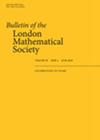Beauville-Mukai系统的双几何III:渐近行为
IF 0.8
3区 数学
Q2 MATHEMATICS
引用次数: 0
摘要
假设Picard秩1的K3曲面S$ S$上的点的Hilbert格式允许一个有理拉格朗日颤振。我们证明了如果曲面的度与点的数量相比足够大,那么希尔伯特格式是其两国类中唯一的hyperkähler流形。特别地,希尔伯特方案本身就是一个拉格朗日颤振,我们认识到它来自S$ S$的傅里叶- mukai伙伴上的(扭曲的)Beauville-Mukai系统。我们还表明,当表面的度很小时,我们的方法可以用来找到希尔伯特格式的所有birational模型。本文章由计算机程序翻译,如有差异,请以英文原文为准。
Birational geometry of Beauville–Mukai systems III: Asymptotic behavior
Suppose that a Hilbert scheme of points on a K3 surface of Picard rank one admits a rational Lagrangian fibration. We show that if the degree of the surface is sufficiently large compared to the number of points, then the Hilbert scheme is the unique hyperkähler manifold in its birational class. In particular, the Hilbert scheme is a Lagrangian fibration itself, which we realize as coming from a (twisted) Beauville–Mukai system on a Fourier–Mukai partner of . We also show that when the degree of the surface is small our method can be used to find all birational models of the Hilbert scheme.
求助全文
通过发布文献求助,成功后即可免费获取论文全文。
去求助
来源期刊
CiteScore
1.90
自引率
0.00%
发文量
198
审稿时长
4-8 weeks
期刊介绍:
Published by Oxford University Press prior to January 2017: http://blms.oxfordjournals.org/

 求助内容:
求助内容: 应助结果提醒方式:
应助结果提醒方式:


